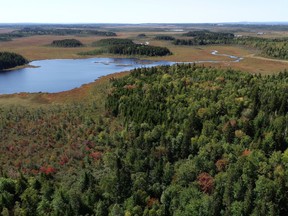Chignecto Isthmus solution to be decided by end of June: Minister
That’s as the Higgs government revealed it has earmarked money in its latest budget towards safeguarding the Chignecto Isthmus

Article content
The preferred plan to safeguard the vulnerable strip of land connecting New Brunswick to Nova Scotia will be decided by the end of June, says Infrastructure Minister Richard Ames.
That’s as the Higgs government revealed on Thursday it has earmarked money in its latest budget for preliminary steps toward safeguarding the Chignecto Isthmus.
The new details provided by Ames came amid a back and forth inside the provincial legislature over efforts to safeguard the low-lying land under threat by rising sea water.
“The team is certainly working on this because it is obviously very important, not just to us but Nova Scotia and the country as a whole,” Ames said in response to questions on his department’s spending in the fiscal year ahead.
“There is money in the budget.”
But that amount is $750,000, dollars Ames said are earmarked for further data collection, preliminary design, final design, Indigenous consultation, stakeholder engagement, regulatory work, and land acquisition.
That’s as New Brunswick and Nova Scotia have submitted a joint application to Ottawa for what’s estimated to be a $650-million project.
The feds, to date, are only willing to pay half of that price tag.
It means the two provinces would split a remaining $325 million.
Green MLA Megan Mitton attempted to ask Ames on Thursday what that means to future budgets, a line of questioning the minister declined to engage in, only speaking to the work that’s happening now.
Ames said the earmarked dollars are to “finalize a preferred route.”
“And we should have the preferred route by the end of June,” he said.
Pressed for what option will go ahead, Ames said on Thursday that “nothing is set in stone.”
A 2019 study came up with three options that included raising the existing dikes, building new dikes, or raising the existing dikes and installing steel sheet pile walls.
The provinces have since filed an application for federal disaster mitigation funding carrying a cost estimate of $650 million for the project, although not for a specific fix.
In front of a Senate committee in Ottawa last year, Peter Hackett, Nova Scotia’s deputy minister of Public Works, said that cost was “based on several scenarios for the final design which is expected to contain elements from all three options identified in the feasibility study.”
Meanwhile, Nova Scotia and New Brunswick have also turned to the court in attempts to prove it’s the feds who should foot the entire bill.
Liberal MLA Chuck Chiasson used the estimates process on Thursday to question the minister’s efforts on getting a deal with Ottawa.
“This is a project of national importance, this government is really fast to point the finger at Ottawa as an excuse to all of their shortcomings, ‘let’s blame it on Ottawa,’ but when it comes to picking up the phone and actually talking to Ottawa there seems to be a reluctance there,” Chiasson said.
“There seems to be a huge lack of urgency around this and there could be, at any given time, what’s there can let go.”
Andrew Black, the president of the Union of Municipalities of New Brunswick and the mayor of Tantramar, the recent amalgamation of Sackville and Dorchester, told a Senate committee last year that safeguarding the strip of land connecting the province to Nova Scotia can’t wait.
“I am here today to speak to you about the tenuous position that my community is in regarding the Chignecto Isthmus, and the fear and concern that we live with day by day,” Black said.
“There is constant dread that it will all be washed away in one perfect storm.”
Black was also joined by Amherst, N.S. Mayor David Kogon.
“A flooded Chignecto Isthmus would disrupt the rail line, the Trans-Canada Highway, the power distribution lines, a natural gas pipeline and the windmills in the area,” Kogon said. “A significant portion of the town of Amherst, estimated at approximately 25 per cent to 33 per cent, would be flooded if the isthmus of Chignecto were to flood.”
An estimated $35 billion in trade each year also crosses the isthmus.
Ames said the department has been speaking with the federal government regularly, going as far to say that talks on the file with Ottawa occur as much as weekly.
“If he wants to create a headline, there isn’t a headline to be created other than we are certainly taking this very seriously, and it is a very important topic, and it’s unfortunate that he’s positioning it that we’re doing nothing which is the complete opposite of the truth,” Ames said.












Postmedia is committed to maintaining a lively but civil forum for discussion. Please keep comments relevant and respectful. Comments may take up to an hour to appear on the site. You will receive an email if there is a reply to your comment, an update to a thread you follow or if a user you follow comments. Visit our Community Guidelines for more information.